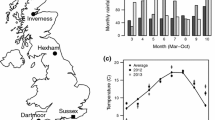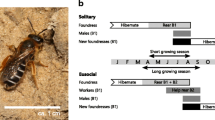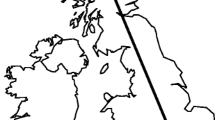Abstract
Sweat bees are one of the most socially polymorphic lineages on the planet. In obligately eusocial species, newly enclosed females may become either queens or workers, depending on the environmental and social circumstances of the nest into which they emerge. In socially polymorphic species, females also have the option of nesting solitarily, founding a nest and raising future reproductives alone, without the help of other adult females. Halictus ligatus is a widespread Nearctic, ground-nesting sweat bee. It has been particularly well studied in Ontario, where detailed studies have described it as obligately eusocial. Here we report evidence that the flexibility of female H. ligatus actually extends to expressing behaviour more typical of socially polymorphic species, those in which some individuals reproduce solitarily. In a population in southern Ontario, black wasps (Astata sp.) emerged from the soil beneath the nesting aggregation and proceeded to excavate their own nesting tunnels, dislocating many H. ligatus nest entrances. Young workers whose natal nests were destroyed by the wasp activity constructed new nests, so under very specific circumstances, it is possible for potential altruists to nest solitarily.

Similar content being viewed by others
References
Costa J.T. and Fitzgerald T.D. 1996. Developments in social terminology: semantic battles in a conceptual war. Trends Ecol. Evol. 11: 285–289
Michener C.D. 1974. Social Behaviour of the Bees. Belknap Press, Cambridge MA
Mueller U.G. 1996. Life history and social evolution of the primitively eusocial bee Augochlorella striata (Hymenoptera: Halictidae). J. Kansas Entomol. Soc. 69: 116–138
Packer L. 1986. Multiple foundress associations in a temperate population of Halictus ligatus. Can. J. Zool. 64: 2325–2332
Richards M.H. and Packer L. 1994. Trophic aspects of caste determination in a primitively eusocial sweat bee. Behav. Ecol. Sociobiol. 34: 385–391
Richards M.H. and Packer L. 1995. Annual variation in survival and reproduction of the primitively eusocial sweat bee Halictus ligatus (Hymenoptera: Halictidae). Can. J. Zool. 73: 933–941
Richards M.H. and Packer L. 1998. Demography and relatedness in multiple foundress nests of the social sweat bee, Halictus ligatus. Insect. Soc. 45: 97–109
Richards M.H., Packer L. and Seger J. 1995. Unexpected patterns of parentage and relatedness in a primitively eusocial bee. Nature 373: 239–241
Richards M.H., Vickruck J. and Rehan S.M. 2010. Colony social organization of Halictus confusus in southern Ontario, with comments on the sociality in the subgenus H. (Seladonia). J. Hymenopt. Res. 19: 144–158
Sakagami S.F. 1977. Seasonal change of nest survival and related aspects in an aggregation of Lasioglossum duplex (Dalla Torre), a eusocial halictine bee (Hymenoptera: Halictidae). Res. Popul. Ecol. 19: 69–86
Schwarz M.P., Richards M.H. and Danforth B.N. 2007. Changing paradigms in insect social evolution: insights from halictine and allodapine bees. Annu. Rev. Entomol. 52: 127–150
Wcislo W.T. 1997. Are behavioural classifications blinders to studying natural variation? In: The Evolution of Social Behaviour in Insects and Arachnids (Choe J.C. and Crespi B.J., Eds), Cambridge University Press. pp 8–13
Yagi N. and Hasegawa E. 2012. A halictid bee with sympatric solitary and eusocial nests offers evidence for Hamilton’s rule. Nat. Commun. 3: 939
Acknowledgments
Special thanks to Karmi Oxman for the illustrations in Fig. 1. This work was supported by NSERC scholarships to SMR and NSERC Discovery grants to MHR.
Author information
Authors and Affiliations
Corresponding author
Rights and permissions
About this article
Cite this article
Rehan, S.M., Rotella, A., Onuferko, T.M. et al. Colony disturbance and solitary nest initiation by workers in the obligately eusocial sweat bee, Halictus ligatus . Insect. Soc. 60, 389–392 (2013). https://doi.org/10.1007/s00040-013-0304-8
Received:
Revised:
Accepted:
Published:
Issue Date:
DOI: https://doi.org/10.1007/s00040-013-0304-8




